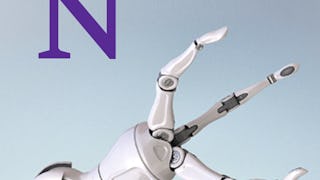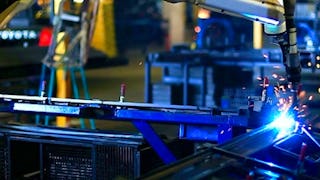Robotics Basic is an introductory course that provides a structured, hands-on overview of industrial robotics. Over 13 compact modules, learners explore the mechanical, electrical, and digital components that make up modern robotic systems.



Skills you'll gain
- Machine Controls
- Engineering
- Automation Engineering
- Safety and Security
- Mechanical Design
- Equipment Design
- Safety Standards
- Computer Programming
- Human Machine Interfaces
- Product Automation
- Programming Principles
- Automation
- Manufacturing Standards
- Human Factors
- Industrial Engineering
- Performance Testing
- Control Systems
- Manufacturing and Production
- Robotic Process Automation
Details to know

Add to your LinkedIn profile
4 assignments
August 2025
See how employees at top companies are mastering in-demand skills

There are 4 modules in this course
This introductory module provides a comprehensive foundation for understanding the essential structure and role of industrial robots. Learners begin by exploring the definition and basic characteristics of robots, including the core components of robotic systems and how these systems support automation in modern production environments. They will then be introduced to the various types of robotic systems and their integration into industrial workflows. Emphasis is placed on component structures, functional capabilities, and safety considerations of entire robotic systems. Finally, the module addresses the classification of robots based on structural and functional criteria and explores typical application areas. Participants will learn to distinguish between conventional industrial robots and lightweight robots, understand their use cases, and reflect on how robotics is shaping today’s manufacturing and logistics industries.
What's included
5 readings1 assignment3 plugins
This module dives deeper into the technical and functional properties that define the performance of modern robotic systems. It begins with robot kinematics, where learners will explore serial and parallel structures, degrees of freedom, and coordinate systems. This provides the basis for understanding how robots move and operate in space. In the following unit on human-robot collaboration, learners will study different modes of interaction, including cooperation, coexistence, and full collaboration—with a focus on safety, technical requirements, and ethical considerations. The module then turns to performance-related criteria, starting with accuracy and repeatability, including common causes of deviation and the importance of calibration. In the units on drive systems and end effectors, participants examine mechanical design, gear types, motor systems, and the selection of grippers or tools based on the task at hand. The module concludes with position measurement technologies (absolute vs. incremental) and motion control strategies such as point-to-point, continuous path, and circular interpolation. Together, these elements form the core of robot system performance and usability in real-world environments.
What's included
7 readings1 assignment7 plugins
The third module focuses on the regulatory and safety-related dimensions of industrial robotics. It begins with an overview of programming strategies, including online methods (e.g., teach-in, master-slave) and offline programming (e.g., simulation, text-based). Learners will understand when to apply which approach and what tools are commonly used—such as the TIA Portal. The next unit addresses the legal and normative framework. Key elements include the EU Machinery Directive, ISO/TS 15066 for collaborative robots, and the structure of A-, B-, and C-level safety standards. Central to this is the five-step process of conducting a proper risk assessment for robotic systems. The final unit translates these concepts into practical safety implementations: learners identify zones within a robot cell (hazard, safe, and collaborative), explore safety components such as light curtains and emergency stops, and understand the role of operating modes and system interlocks. This practical view ensures that learners are well prepared to handle safety compliance in real-world installations.
What's included
3 readings1 assignment3 plugins
This introductory module provides a comprehensive foundation for understanding the essential structure and role of industrial robots. Learners begin by exploring the definition and basic characteristics of robots, including the core components of robotic systems and how these systems support automation in modern production environments. They will then be introduced to the various types of robotic systems and their integration into industrial workflows. Emphasis is placed on component structures, functional capabilities, and safety considerations of entire robotic systems. Finally, the module addresses the classification of robots based on structural and functional criteria and explores typical application areas. Participants will learn to distinguish between conventional industrial robots and lightweight robots, understand their use cases, and reflect on how robotics is shaping today’s manufacturing and logistics industries.
What's included
2 readings1 assignment
Instructor

Offered by
Why people choose Coursera for their career




Explore more from Physical Science and Engineering

University of Leeds

L&T EduTech

Northwestern University


